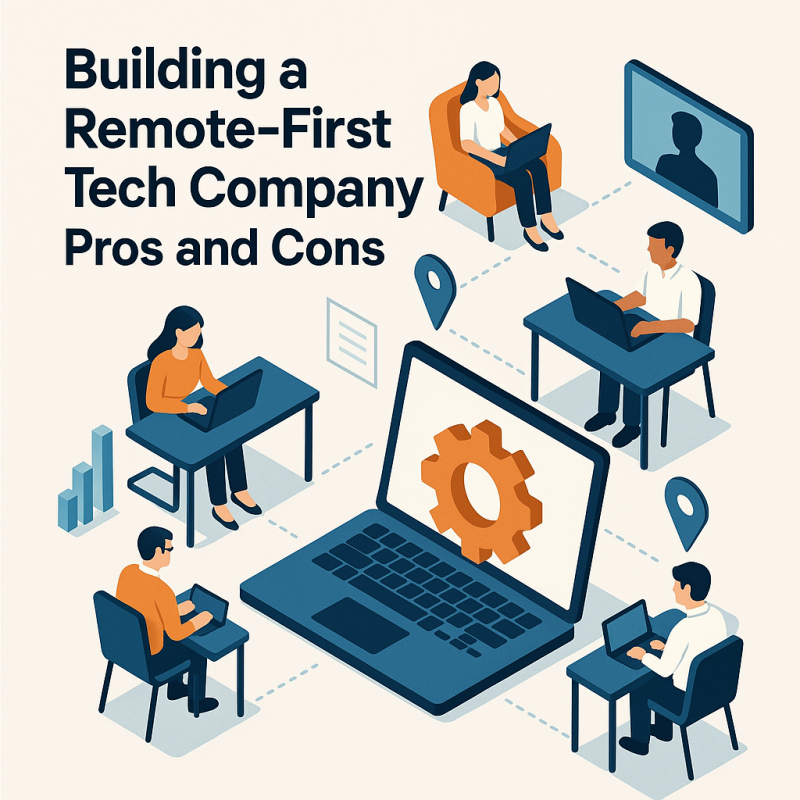Table of Contents Show
Not long ago, the idea of a remote-first tech company sounded radical. Now, it’s rapidly becoming the norm – especially after the global shift in work culture post-2020. Startups, scale-ups, and even massive tech giants are embracing remote-first structures to access global talent, reduce costs, and adapt to new workforce expectations. But it’s not all sunshine and virtual coffee breaks. Building a remote-first tech company comes with both rewards and real challenges.
If you’re thinking of going remote-first – or if you’ve already taken the plunge – this deep dive (based on my own personal experiences) will help you understand what works, what doesn’t, and what needs serious planning.
What Is a Remote-First Company?
A remote-first company is one where the default mode of working is remote, not in-office. Unlike remote-friendly companies, which allow working from home occasionally or by exception, remote-first companies design their workflows, culture, hiring, and operations around a distributed workforce.
Some companies still maintain offices or offer co-working spaces, but physical presence isn’t required for productivity, promotions, or participation. Remote-first is not an afterthought – it’s the main strategy.
The Major Pros of a Remote-First Tech Company
1. Access to a Global Talent Pool
No longer restricted by geography, you can hire the best people for the job – wherever they are. Want a developer in Bangalore, a designer in Berlin, and a product manager in Boston? Done.
Why it matters: Talent shortages are a major challenge in tech. A remote-first model helps fill roles faster and more cost-effectively.
| Traditional Hiring | Remote-First Hiring |
|---|---|
| Local or relocation required | Global access to specialists |
| Slower time-to-hire | Faster hiring cycles |
| Costly packages for relocation | Competitive pay adjusted for location |
2. Lower Overhead Costs
Forget expensive downtown offices, utility bills, and overpriced office snacks. With a remote-first structure, you reduce or eliminate many of these costs entirely.
This includes:
- Real estate
- Office supplies
- Daily commuter benefits
- On-site support staff
Many remote-first companies reallocate those funds into better tools, team perks, or higher salaries.
3. Increased Productivity (Usually)
Contrary to outdated assumptions, remote workers often outperform their office counterparts – especially in focused, asynchronous work like software development or writing.
Studies suggest remote workers put in more hours, take fewer breaks, and produce higher-quality work, provided the right systems are in place.
However, this depends on:
- Clear goals
- Strong communication
- The right software stack
4. Flexibility = Employee Happiness
Flexible schedules mean people work when they’re most productive. Early riser? Night owl? Parent? A remote-first company lets you live your life and do your job well.
Result: Improved morale, lower churn, and stronger employee loyalty.
According to Owl Labs, companies that allow remote work have 25% lower employee turnover than those that don’t.
5. Business Continuity
Pandemics, power outages, local disruptions – none of it stops a remote-first team. Distributed teams are resilient by design. With people spread across regions and time zones, you’re less likely to experience complete downtime.
This has become a critical advantage in uncertain times.
The Big Cons of a Remote-First Tech Company
1. Communication Can Suffer
This is the number one pain point. Without face-to-face interaction, communication becomes slower, more complex, and more prone to misunderstanding.
Remote-first companies must be obsessed with:
- Clear documentation
- Overcommunication (but not micromanagement)
- Async tools like Slack, Notion, Loom, and project management software
Poor communication leads to duplicated work, burnout, or confusion.
2. Onboarding Can Be Lonely
New hires often feel disconnected or lost. They miss the spontaneous interactions and social cues that help them settle in fast.
Remote onboarding needs:
- Structured schedules
- Clear documentation
- Assigned mentors or buddies
- Frequent check-ins
Without this, you risk high early churn.
3. Time Zones Are a Real Issue
It’s romantic to say “we hire globally,” but working across time zones can be a nightmare if not handled well.
Some projects need real-time collaboration, and when team members have a 10-hour gap, that can cause delays or frustration.
Strategies that help:
- Async-first culture
- “Core hours” where everyone overlaps
- Geographic hiring clusters
4. Culture Is Harder to Build
Let’s be honest: culture takes more than Slack emojis and virtual pub quizzes. In a remote-first company, you must intentionally create culture, or you won’t have one at all.
That means:
- Documenting values
- Creating rituals
- Encouraging social interactions (virtual coffee chats, interest-based channels)
- In-person meetups (yes, they’re worth the money)
5. Management Skills Must Evolve
Many managers aren’t trained to lead remotely. Traditional management often relies on visibility, which doesn’t work in a remote-first setup.
Instead, managers must:
- Trust output, not hours
- Set clear expectations
- Embrace asynchronous check-ins
- Use project-tracking tools (like Jira, Linear, or Trello)
Micromanagers do not thrive in remote-first companies. If your team leaders can’t shift mindsets, the company will struggle.
The Software Stack You’ll Need
Remote-first companies rely heavily on digital tools. Here’s a quick cheat sheet of core categories and examples:
| Function | Tool Examples |
|---|---|
| Communication | Slack, Microsoft Teams |
| Async Video | Loom, Claap |
| Video Meetings | Zoom, Google Meet |
| Docs & Collaboration | Notion, Confluence, Google Docs |
| Task Management | Jira, Trello, ClickUp |
| Time Tracking | Toggl, Clockify, Harvest |
| HR & Payroll | Deel, Remote.com, Gusto |
| Employee Engagement | Lattice, CultureAmp, 15Five |
| Cloud Storage | Dropbox, Google Drive, OneDrive |
Pick tools that match your company size, culture, and workflows. Don’t overload your team with apps – more tools ≠ better productivity.
The Hiring & Interview Process in a Remote-First World
Remote-first hiring requires trust, clarity, and strong screening mechanisms. You’re not just looking for skill – you’re also hiring for self-motivation, communication skills, and remote-readiness.
Tips:
- Use pre-interview tasks to assess real-world ability
- Include asynchronous communication in the process
- Ask about their home office setup
- Be honest about expectations and time zones
Some companies even include a paid trial project as a final interview step.
When Remote-First Doesn’t Work
Not every startup should be remote-first. Here are red flags:
| Problem | Why Remote May Not Be Ideal |
|---|---|
| Highly synchronous work | Needs real-time collaboration |
| Low trust in leadership | Micromanagement culture will clash |
| Weak documentation habits | Remote thrives on clear, written communication |
| Early-stage chaos | In-person energy can speed up iteration |
| Lack of remote skills | Employees unfamiliar with tech/tools |
Being remote-first is a choice that needs deliberate design – not just sending everyone home with a laptop.
The Hybrid Trap
Some companies try to be both – remote-friendly but office-leaning. This can backfire if it creates a two-tier system where remote workers feel like second-class citizens.
In a hybrid structure, you must:
- Avoid “proximity bias” in promotions
- Ensure equal access to decisions and info
- Run all meetings as if everyone’s remote (even if some aren’t)
If you’re not ready to go all-in on remote, don’t fake it.
Case Studies: Who’s Done It Right?
GitLab
GitLab is one of the most famous all-remote companies, with over 1,000 employees in 65+ countries. They credit their success to radical documentation, transparency, and an async-first culture.
They publicly share their entire company handbook – thousands of pages long.
Basecamp (Now 37signals)
Basecamp has long championed remote work. Their philosophy emphasizes calm productivity, reduced meetings, and trusting people to manage their time.
Their book Remote: Office Not Required became a manifesto for remote culture.
Zapier
Zapier has grown to over 800 employees without a central HQ. They’ve built robust processes around async communication, clear KPIs, and regular virtual bonding events.
They also offer annual in-person retreats to build connection.
Planning a Remote-First Tech Company? Here’s a Starter Checklist
| Task | Details |
|---|---|
| ✅ Define remote-first values | Document expectations, trust model, and async rules |
| ✅ Choose core tools | Don’t overtool – start with 5-6 essentials |
| ✅ Set up legal/HR systems | Use services like Remote.com, Deel, or Oyster |
| ✅ Build onboarding processes | Include welcome docs, mentors, 30/60/90 plans |
| ✅ Train managers | Focus on output management, not time tracking |
| ✅ Create feedback loops | Pulse surveys, engagement platforms, 1:1s |
| ✅ Plan real-life meetups | Even once a year is better than never |
Final Thoughts: Is It Worth It?
Building a remote-first tech company can unlock serious advantages – cost savings, global hiring, flexibility, and resilience. But it’s not plug-and-play. You need discipline, systems, and intentional culture-building to make it work.
For some founders, it’s the only way to build a modern company. For others, the effort might outweigh the gains.
If you’re clear on your why, and you’re ready to rethink how teams work – you might just build something remarkable.









